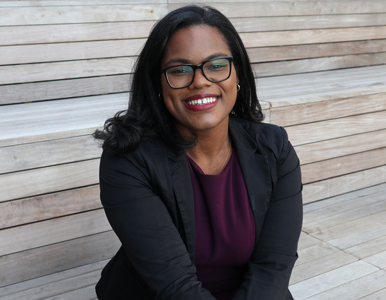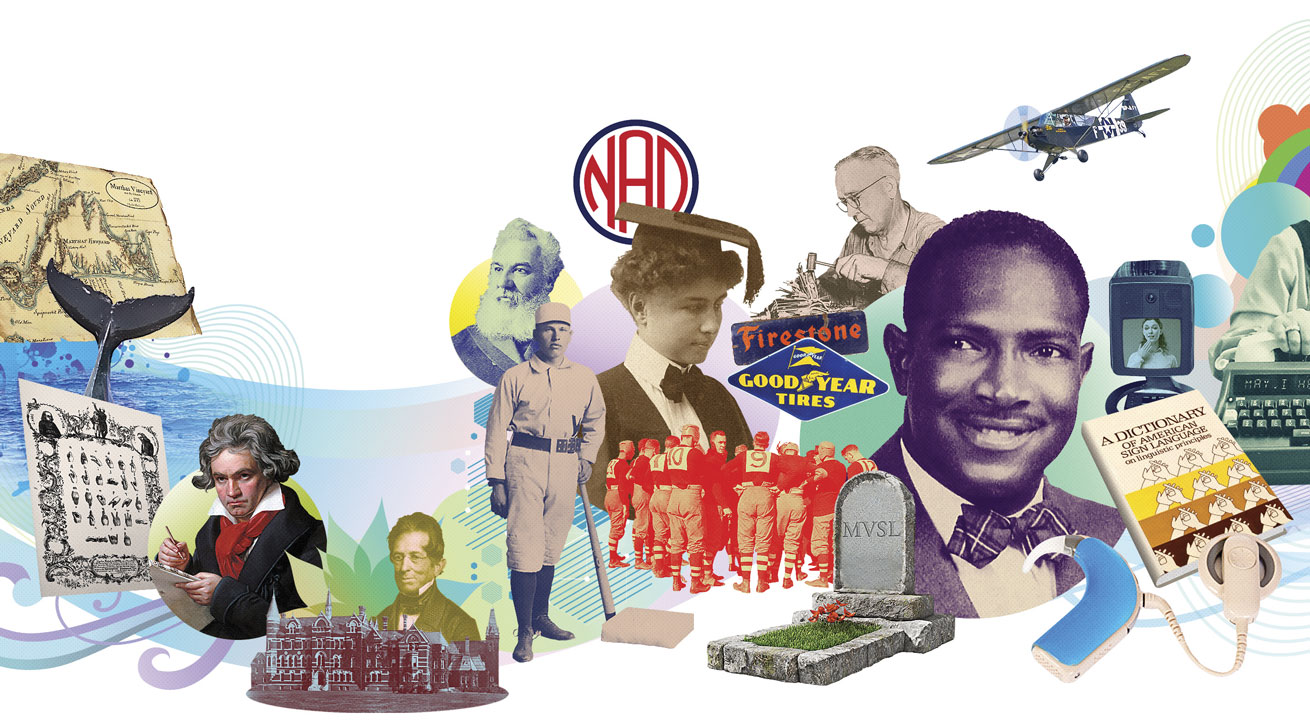
If this sentence was said aloud, someone reading lips would only capture 30 percent of it.
As cofounder and COO of Sign-Speak—a start-up technology that uses machine learning to translate American Sign Language (ASL) to English and vice versa in real time with the tap of an app—Yamillet Payano, CAS/BS ’18, is 100 percent committed to revolutionizing communication by making it more accessible to the 230 million people around the globe who are deaf or hard of hearing (D/HH).
“What we’re doing right now isn’t working, so let’s break it,” says Payano, who in September was named one of Washington’s 25 top innovators under 25 by DC Inno.
ASL was developed by deaf people for deaf people. It’s separate and distinct from English, with its own grammar and structure. Sign-Speak provides a seamless bridge between the two—no 3D cameras, ASL gloves, or other costly gadgets required.
“We’re moving into a service-based economy,” Payano says. “If we think about where we’re headed, customer service is going to be a differentiating factor.”
Rising above the rest is something Payano knows a little something about.
A first-generation college student and first-generation American, Payano came to AU on a prestigious Gates Millennium Scholarship—one of only 1,000 recipients among 54 times as many applicants. News of her full ride came while she was touring campus. “I took that as a sign that I should come to AU,” she says.
The math and economics major made her mark, founding the Cross Campus Organizing Network to advocate for immigration policy reform, serving as Student Government president, and studying abroad for a year at Peking University, where she honed her Mandarin skills. She also helped establish the President’s Council on Diversity and Inclusion—the same guiding principles that prompted her to quit her job as a quantitative analyst for Fannie Mae’s fair lending team at the end of 2020 and join Sign-Speak.
“I jumped on board without even seeing the technology. I didn’t need proof of concept,” she says. “I know that the next Google will be a company that puts people at its center, that attracts talent who are motivated by making the world better.”
And that company, she believes, is Sign-Speak.
The team—Payano, CEO Niko Kelly, who is deaf, and CTO Nicholas Wilkins—began beta testing in January 2021. Among their partners: Mozzeria, a D/HH-owned and operated pizzeria that opened near Gallaudet University in Northeast in September 2020.
Using an iPad to communicate with the D/HH employee on the other side of the counter, a nonsigning customer can order a Neapolitan-style pie in English. Sign-Speak translates the transaction into ASL on the employee’s iPad faster than the patron remembers to say, “extra cheese.” The New York–based company has also created systems especially for kitchen staff and delivery people.
Sign-Speak plans to bring their nonprovisional patent technology to market next year. The $100,000 award Payano just received from the prestigious Google for Startups Black Founders Fund will go a long way toward meeting that goal.
Payano knows that for businesses like Nike—which was slapped with a first-of-its-kind lawsuit in September 2020 by a D/HH customer who claimed the retailer violated Title III of the Americans with Disabilities Act (ADA) amid the pandemic—adapting Sign-Speaks is a matter of dollars and common sense.
D/HH Americans, who number about 48 million, represent $87 billion a year in purchasing power. “That’s a whole economy,” she says. “Businesses are leaving money on the table, but they’re also being hit with fines of at least $75,000 for failing to comply with the ADA. Ninety percent of businesses say they’re committed to diversity and inclusion—but unfortunately, often the way you make them act on it comes down to the numbers.”
That Sign-Speak has the ability the serve 32 million American businesses across a variety of sectors is good for everyone’s bottom line. But the bottom line for Payano is that she’s changing people’s lives.
“I want to look back on my life and know that I fought for something, the way other people fought for me,” she says. “The world is changing. People are becoming more aware of those who are not being seen. I am motivated to wake up every morning and ask: ‘Who are we still missing?’”
Deaf Culture and History: A Timeline

1714: Martha’s Vineyard Sign Language (MVSL) is developed by deaf residents, who comprise as much as 25 percent of the population.
1760: French Sign Language (LSF) is used by teachers at a free school for the deaf.
1817: Thomas Gallaudet, an American educator, and Laurent Clerc, a deaf man from France, open the Hartford Asylum for the Education and Instruction of the Deaf and Dumb, the first school of its kind in the US.
MVSL and LSF combine to form American Sign Language (ASL).
1824: Ludwig van Beethoven, who began losing his hearing at the turn of the nineteenth century, debuts what is widely regarded as his greatest work: “Symphony No. 9.”
1864: Gallaudet University is chartered by President Lincoln as a grammar school for deaf and blind children.
1880: At the Second International Congress on Education of the Deaf in Milan, oral education—communication through speech and lip-reading—is declared superior to manual education, and ASL is banned in schools. The debate includes three days of testimony from Alexander Graham Bell, an advocate of oralism, and only three hours from ASL supporters.
The National Association of the Deaf (NAD) is established to advocate for the rights of deaf Americans—however, Black members are not admitted for another 85 years.
1888: Deaf centerfielder William Hoy makes his debut with the Washington Nationals, leading the league in stolen bases his rookie year. Hoy would create the hand signals that are still used in baseball today.
1892: Gallaudet quarterback Paul Hubbard invents the huddle to keep opposing players from seeing him sign plays to his teammates.
1904: Helen Keller, the first deaf-blind person to earn a bachelor’s degree, graduates with honors from Radcliffe.
1924: The International Committee of Silent Sports, later renamed the International Committee of Sports for the Deaf, and the International Silent Games, now known as the Deaflympics, are born. Paris hosts the inaugural games, featuring 148 athletes from nine European nations.
1941: As hearing men deploy to the front during World War II, deaf Americans take their place in factories. In Akron, Ohio, Goodyear and Firestone hire deaf workers by the hundreds—although most lose their jobs at the end of the war.
1947: Rhulin Thomas becomes the first deaf pilot to successfully fly coast-to-coast.
1952: Kate West, the last deaf person from Martha’s Vineyard who uses MVSL, dies, rendering the language extinct.
1954: Andrew Foster becomes the first Black graduate of Gallaudet, which only began admitting African American students in 1950. He would later launch 32 schools for the deaf in 13 African countries.
1960: Robert Weitbrecht invents the teletypewriter (TTY), a device that sends a typed message to another place, greatly expanding long-distance communication for the deaf.
1961: The cochlear implant is invented.
1964: Weitbrecht’s Video Relay Service allows ASL users to communicate with voice telephone users through video equipment, rather than through typed text.
The Babbidge Report issued by Congress declares oralism a “dismal failure.”
1965: Arguing that sign language has a unique syntax and grammar, linguist William Stokoe and two deaf colleagues create the first ASL dictionary.

1968: Audree Norton becomes the first deaf actress to appear on American network TV, starring in an episode of the CBS crime drama Mannix. She plays a deaf woman who foils a kidnapping plot by reading the attacker’s lips.
1971: Linda Bove begins her 31-year stint as Sesame Street’s resident librarian—the longest-running role for a deaf person in the history of TV.
1972: Professor James Woodward, a hearing man, proposes using deaf to refer to the audiological condition of deafness, and Deaf to refer to culture.
1973: The Rehabilitation Act prohibits discrimination on the basis of disability in programs conducted by federal agencies.
1975: The mainstreaming of deaf children in public schools begins with the passage of Public Law 94-142.
1980: ABC, NBC, and PBS debut closed-captioned TV shows.
1982: National Black Deaf Advocates—which now boasts 30 chapters across the US—is founded.
1988: A week-long protest by Gallaudet students leads to the inauguration of the university’s first deaf president, I. King Jordan.
1990: The Americans with Disabilities Act prohibits discrimination based on disability.
2006: The American Library Association officially declares March 13–April 15 Deaf History Month.
2011: Black graduates of the Kentucky School for the Deaf finally collect the diplomas denied to them 60 years earlier because of their race.
2012: The 21st Century Communications and Video Accessibility Act mandates that all televised material be captioned, including its online distribution.
2018: Amazon becomes the first tech company to hire full-time ASL interpreters for its deaf employees.
2021: On the heels of a lawsuit filed by NAD, the White House begins using an ASL interpreter for all its news briefings.